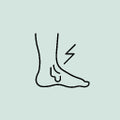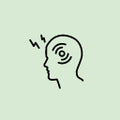Pain is a warning signal essential for survival. During his life, Man will be subjected to several stimuli of pain, of different intensities and of various origins.
Pain, or at least the feeling of pain, is a very subjective phenomenon. The same stimulus can be perceived differently by each individual or even by the same person depending on the environmental context.
Here we will seek to find out what is happening with neuropathic pain and in particular what link exists between neuropathic pain and stress .
Where does pain come from?
Pain is the result of the stimulation of one or more nerve fibers specialized in the perception of pain. The stimulus, of mechanical, chemical or thermal origin, will trigger a mechanism of information transmission thanks to receptors called nociceptors .
Nociceptors are located in the skin, muscles, joints, etc. They will translate a stimulus into a nerve impulse to convey information to the central nervous system.
Chronic pain in a nutshell
According to Inserm, 30% of adults suffer from chronic pain. This prevalence increases with age and affects women more. Pain is considered chronic when it lasts for more than 3 months or more than 1 month after resolution of the pathology or injury from which the pain originated. It is a pain that can disappear and reappear over time, for months or sometimes even years.
It is usually associated with a chronic disorder (cancer, arthritis, diabetes or fibromyalgia) or an injury that does not heal. Chronic pain can affect the nervous system. In fact, nerve fibers and cells are repeatedly stimulated, which causes changes in their structure and makes them more sensitive to new stimulations.
In the case of chronic pain, pain is no longer considered a symptom, it becomes a disease. Pathophysiological mechanisms are then triggered such as inflammatory pain, neuropathic pain (damage to the central nervous system), mixed pain (which combines an inflammatory and neuropathic component) or nociplastic pain (alteration of nociception).
What about neuropathic pain?
Neuropathic pain, also called neuralgia, is caused by a failure of the somatosensory system. It was defined in 1994 by the IASP (International Association for the Study of Pain) as "pain initiated or caused by a primary lesion of the dysfunction of the nervous system."
In fact, this system can present lesions or a dysfunction due to a disease. This dysfunction can cause painful syndromes at the level of the peripheral and central nervous system.
Epidemiological studies have shown that the prevalence of these neuropathic pains varies between 7 and 8% in the general population (1) with a peak between 50 and 64 years of age. Neuropathic pain affects 20 to 25% of people suffering from chronic pain.
What causes neuropathic pain?
Neuropathic pain can be the result of several pathologies.
These include polyneuropathies in metabolic disorders (such as diabetes), and disorders of the blood supply to the extremities (in arterial occlusion disease).
Neuropathic pain can also occur after viral infections (acute shingles), trigeminal neuralgia , in the case of rheumatic pain (such as fibromyalgia), after an amputation (this is called phantom pain). Nerve damage due to chronic compression of one or more nerves (carpal tunnel syndrome, sciatica, herniated disc, osteoporosis, etc.) or due to the installation of a tumor , or toxic nerve damage can also cause neuropathic pain.
How to recognize neuropathic pain?
Neuropathic pain can be perceived in different ways. Abnormal, non-painful sensations may occur, such as tingling or numbness. These sensations correspond to a form of paresthesia or dysesthesia.
The manifestation of neuropathic pain may be more invasive in the case of neurological sensory deficits that induce painful areas and other failures depending on the location of the lesion (motor deficits, cognitive deficits, etc.).
Overall, neuropathic pain is felt by persistent pain (burning), or short, but repetitive pain (electric pain, spasms, etc.). Unpleasant sensations, painful hypersensitivity to the slightest contact, and radiating pain.
Can stress be classified as pain?
Stress is a phenomenon that results in an emotional and physical reaction that allows the body to react quickly to a disturbance in the environment.
It manifests itself differently in each individual, but is mostly perceived as something unpleasant to bear. Stress is often experienced as painful.
In a stressful situation, the body perceives a threat and tries to respond by activating the secretion of catecholamines through the sympathetic nervous system (adrenaline and noradrenaline) and neuroendocrine hormones (cortisol). This will induce an increase in heart rate, blood pressure and breathing.
In the short term, this reaction is pro-inflammatory, a production of cytokines has in fact been observed when the body is in a stressful situation (molecules involved in the inflammation process). The secretion of all these hormones allows the body to react quickly and effectively (at least in theory, it is the law of "fight or flight").
The balance between the sympathetic and parasympathetic nervous system
Neurologically, there is a continuum between the functioning of the sympathetic system (rapid and immediate action) and the parasympathetic system (enables the body to function at rest, such as the heartbeat or digestion).
The sympathetic nervous system enables the body to be alert, vigilant and to act quickly and efficiently. To do this, it enables the mobilization of energy via the body's glucose reserves (by activating the use of storage pathways or by degrading certain types of tissues).
The parasympathetic nervous system allows the body to function at rest. More specifically, it allows the body to recover at rest. That is, to replenish energy stores, repair damaged tissues and ensure the maintenance of immunity.
These two systems must function in balance over the long term. If there is a discontinuity in this balance, the organism cannot function optimally.
The effects of cortisol on the body
Cortisol is a so-called catabolic hormone, produced by the adrenal glands. Throughout the day, this hormone helps maintain normal blood sugar levels to ensure the brain and neuromuscular tissues are supplied with energy (more precisely glucose).
Indeed, it is a very powerful anti-inflammatory hormone whose function is to quickly mobilize energy from the body's glucose reserves. During prolonged stress, there is a dysfunction of cortisol and therefore of the vectors of inflammation.
During a stressful situation, cortisol will be secreted in greater quantities to provide the body with the means to respond quickly and effectively to an environmental disturbance. The glucose that it will mobilize will serve as an energy support for the brain so that it adapts to rapid decision-making, and for the muscles in order to prepare the body to react to the information transcribed by the brain.
The consequences of stress in humans
In humans, stress -induced inflammation is implicated in diseases such as osteoporosis, rheumatoid arthritis, myopathy, fibromyalgia, chronic fatigue syndrome, chronic pelvic pain, temporomandibular joint dysfunction, chronic low back pain, sciatica, etc. (4).
Cortisol, due to chronic stress, triggers an inflammatory response and induces oxidative stress . Oxidative stress is defined by the alteration of free radicals of certain molecules accelerating apoptosis (process of cellular degeneration) and therefore aging and systemic degeneration of tissues.
The visible symptoms of chronic stress will be related to bone and muscle fatigue, depression, physical and psychological pain, memory disorders, acid-base deregulation of the body (largely linked to oxidative stress, which will increase the risk of injury), orthostatic hypotension and an alteration of the ocular light reflex. Chronic stress therefore has repercussions in the form of multifactorial events contributing to many inflammatory diseases and exhaustion of the immune system.

What is the link between neuropathic pain and stress?
Acute pain can be translated as a spontaneous disturbance of the individual's environment. In this case, pain, by this definition, will therefore be perceived as environmental stress. Stress is inevitable and necessary in human daily life. But when stress becomes chronic, a hormonal imbalance can be created.
Research has highlighted a possible neuroendocrine alteration caused by cortisol. As explained earlier, cortisol is a hormone secreted during a stressful situation. If this stress is prolonged, even chronic, a resistance of cells to cortisol can appear. There will be, what is called, a depletion of cortisol.
Neuropathic pain causes a constant sensory overload of cells due to prolonged pain. Neuropathic pain can therefore be a vector of stress and vice versa, creating a real vicious circle that is difficult to get rid of. Finally, we observe here the first link between neuropathic pain and stress.
Who to consult for neuropathic pain?
The most effective solution to get rid of neuropathic pain is to anticipate the onset of this pain. To do this, it is important to perform an anamnesis (medical history) and a diagnosis of the patient early. This diagnosis must be made on the basis of the patient's medical history, a physical and neurological examination and possible objective proof provided by electrophysiological or cross-sectional imaging procedures (CT, MRI).
The anamnesis generally consists of the following questions: When did the pain appear? Where and when does the pain occur? How often, how intensely and at what time of day? How is it expressed? What increases or decreases this pain? Are there other symptoms that accompany this pain? How does it impact your quality of life (work, social, family)?
Then, regarding the medical examination, the general physical condition will first be analyzed, followed by the neurological examination. The neurological examination will include monitoring reflexes, general motor skills and sensitivity to pain, temperature, compression and contact. A measurement of nerve conduction velocity by electroneurography can also be done in the case of neuropathic pain. This diagnosis can be made by your doctor. He will then be responsible for referring you to a specialist depending on the origin of the neuropathic pain.
In most cases, he will refer you to a neurologist. But he can also refer you to an orthopedist if the pain comes from a musculoskeletal disease, to a nutritionist in the case of insulin-resistant diabetes, to an immunologist, a toxicologist or doctors specializing in infectious diseases.
How to cure neuropathic pain?
The first treatment that may be prescribed will mostly involve pain relief, whether medicinal or not. It is essential to treat or relieve pain as quickly as possible. In fact, when there is prolonged pain, the body will develop a so-called memory pain, which will lead to painful states that are more difficult to treat. In the case of painful diabetic neuropathy, the appropriate treatment will be prescribed (stabilisation of blood sugar). If the pain results from a crushed nerve, surgery may in some cases resolve the problem.
Drug treatments for neuropathic pain and stress
Neuropathic pain usually requires a long treatment. A combination of several drugs is very frequently necessary in order to effectively relieve the pain and improve the patient's quality of life. Some analgesics can be dispensed without a prescription, however, great care must be taken with self-medication and overdosing in these cases. To effectively combat pain, antidepressants , antiepileptics and opioid analgesics can be prescribed on prescription. These are sometimes added together in a treatment.
Non-drug treatments for neuropathic pain and stress
Sometimes it is possible to avoid taking medications. Physical therapies can limit pain and improve comfort of life.
These therapies include thermal treatments (relaxing, spasmolytic), cryotherapy (for acute inflammatory pain), balneotherapy or physiotherapy (physiotherapy, massage). Some people use acupuncture in addition to drug treatment to relieve the symptoms of neuropathy. There are treatments using transcutaneous electrical nerve stimulation (TENS). These are analgesic methods using electrodes applied to the skin, at the painful area. This method targets the pain and inhibits nociceptive receptors (involved in the transmission of pain).
Other patients manage to improve their comfort of life and reduce pain through certain exercises such as relaxation , meditation , hypnosis or a method called biofeedback . They do not cure neuropathic pain, but they help make the pain more bearable.
Discover our article on 16 natural remedies to fight fibromyalgia.
A natural treatment for neuropathic pain and stress: Hemp
Cannabidiol is a substance known for its relaxing effects. In fact, hemp interacts with the endocannabinoid system and therefore stimulates the synthesis of serotonin and dopamine, two hormones involved in well-being.
Discover our range to fight against fibromyalgia but also against stress and anxiety .
Bibliographic references:
- Bouhassira, D. (2018). Neuropathic pain: Definition, assessment and epidemiology . Revue Neurologique . 1 – 10.
- Ralph Baron; Andreas Binder; Gunnar Wasner (2010). Natural and Neuropathic pain: diagnosis, pathophysiological mechanisms, and treatment . Lancet Neurology , 9(8), 807–819.
- Macone, Amanda; Otis, James (2018). Neuropathic Pain . Seminars in Neurology, 38(6), 644–653.
- Kara E. Hannibal and Mark D. Bishop. (2014). Chronic Stress, Cortisol Dysfunction, and Pain: A Psychoneuroendocrine Rationale for Stress Management in Pain Rehabilitation . Physical Therapy . 94: 1816 – 1825.







